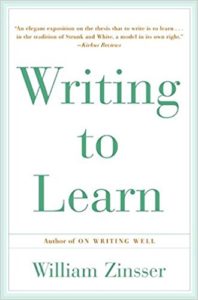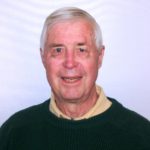 Almost 30 years ago my wife bought and read William Zinsser’s Writing to Learn, with a copy autographed by the author. It has taken all that time for me to find and read this perceptive and challenging work.
Almost 30 years ago my wife bought and read William Zinsser’s Writing to Learn, with a copy autographed by the author. It has taken all that time for me to find and read this perceptive and challenging work.
Late, but perhaps not too late!
The key lies in the title: this is not a “how to” book but rather an encouragement to write, and write, and then write some more, as the critical part of the process of learning.
Zinsser, who died in 2015, wrote for the New York Herald Tribune, The New Yorker, the New York Times, taught at Yale and New York’s Fieldston School, edited the Yale Alumni Magazine, and was extensively published. His key point is “ … writing is a form of thinking … ” He never stopped doing both.
Writing, he explains, “clarifies half-formed ideas.” It is thinking on paper. As our thinking constantly changes, so too should our writing, and, “ … the essence of writing is rewriting,” in the form of the alteration and clarification of our thoughts.
He describes his “liberal” education: Deerfield Academy, Princeton University, the U.S. Army in the War in Europe, newspaper reporting, teaching at Yale, being Master of Yale’s Branford College; and then even more writing, as a lifelong “linear and sequential” process.
Lovely quotes: on rewriting: “I heard the scratching out of words that is the obbligato of a writer’s life,” and on academic writing: “It’s a language squeezed dry of human juices – a Sargasso Sea of passive verbs, long and generalized nouns, pompous locutions and unnecessary jargon.”
His Chapter 5 describes his pet Crochets and Convictions: information and noise; obscurity; voice and tone; brevity (“Brevity is one sign of a well-organized mind.”); jargon; killer nouns (“the pomposity of bureaucratic language”), lifesaving verbs (be active, never passive), and the illiteracy of the elite (corporate over-writing is “scandalous in its flatulence.”)
As Zinsser considered his thesis, he said, “I would write confidently from my own convictions and experiences – take ‘em or leave ‘em – and to illustrate my points I would present passages by writers I admired.”
And so he does …
He begins with William Strunk & E. B. White’s The Elements of Style (“read once a year”) and then on to:
- Physics and Chemistry: Einstein, Primo Levi and Richard Feynman
- Geology: John Muir, Rachel Carson and John Rodgers (Yale)
- Art: John Russell (NYT) and A. Hyatt Mayor (Metropolitan Museum of Art)
- Natural World: Darwin, Roger Tory Peterson (a former Old Lyme resident!), and Archie Carr (University of FL)
- Music: Alec Wilder, Virgil Thomas, and Roger Sessions.
For Mathematics he extensively quotes Joan Countryman, a teacher at Germantown Friends School in Philadelphia: he says music is also “a language” and advises, “keep a journal with a running account of your work.”
And for Memoirs, he cites Lewis Thomas (Lives of a Cell): “it had never occurred to me that a memoir could be pre-natal.” It’s too bad he never read Ian McEwan’s 2016 novel of life before birth, Nutshell.
William Zinsser’s reading marathon is condensed into a 100-yard dash. Read it and write on.
One further comment: William Zinsser and his wife had a summer house in East Lyme for many years, and Caroline Fraser Zinsser wrote a short study of the 1828-1851 letters of Charles and Mary Chadwick of Lyme (he was a sailing captain), which was published by the East Lyme Public Library in 2005.
Editor’s Note: ‘Writing to Learn’ by William Zinsser is published by Harper & Row, New York 1988

About the Author: Felix Kloman is a sailor, rower, husband, father, grandfather, retired management consultant and, above all, a curious reader and writer. He’s explored how we as human beings and organizations respond to ever-present uncertainty in two books, ‘Mumpsimus Revisited’ (2005) and ‘The Fantods of Risk’ (2008). A 20-year resident of Lyme, he now writes book reviews, mostly of non-fiction that explores our minds, our behavior, our politics and our history. But he does throw in a novel here and there. For more than 50 years, he’s put together the 17 syllables that comprise haiku, the traditional Japanese poetry, and now serves as the self-appointed “poet laureate” of Ashlawn Farm Coffee, where he may be seen on Friday mornings. His wife, Ann, is also a writer, but of mystery novels, all of which begin in a village in midcoast Maine, strangely reminiscent of the town she and her husband visit every summer.